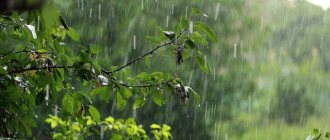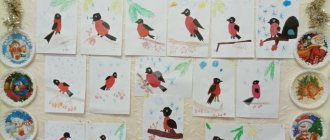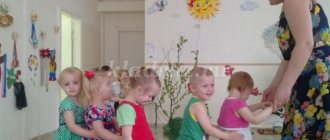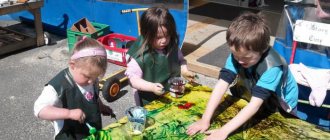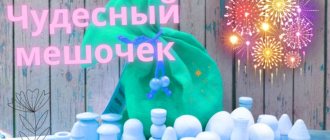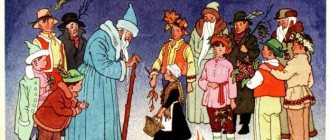Notes on experimentation in the preparatory group “Air and its properties.”
Notes on experimentation in the preparatory group
"Air and its properties."
Educational objective:
— Systematize and clarify children’s ideas about the properties of air.
— Expand children’s understanding of the importance of air in human life.
— Learn to work in a team and individually during experiments.
Developmental task:
— Develop cognitive interest in the process of experimentation.
— Develop the ability to draw conclusions and inferences.
— To develop in children the ability to find connections between inanimate nature and living nature and the objective world.
— Develop thinking, imagination, curiosity, observation.
Educational task:
-Cultivate interest in learning about nature through the element of air.
— Form an emotional positive attitude towards the surrounding world and nature.
Progress:
— Guys, listen carefully to the riddle about one of the factors of inanimate nature:
We need him to breathe
To inflate the balloon,
With us every hour,
But he is invisible to us!
- What is this? (air)
- That's right, it's air. What is air needed for? (to breathe)
- Yes, we are so used to it that we don’t even notice. Well, let's first take a deep breath and then exhale.
- What did you and I inhale? (air)
- Now try not to breathe. Take a deep breath and hold your breath.
- How did you feel when you weren’t breathing? Were you comfortable? (Badly)
- What conclusion can be drawn?
— Air is necessary for breathing; a person cannot live without air.
- Who else breathes air? (birds, animals, plants).
- What would happen if the air disappeared on earth? (there would be no life on earth)
- That's right, then planet Earth would become a lifeless celestial body.
Guys, where and how do people use air? (air helps people: fly airplanes, launch balloons, move sailing ships, turn the wheels of a mill).
— Today in class we will try to answer the questions: “Is there air, where and how to detect it.” And for this, I invite you to become scientists and invite you to our experimental laboratory. Here you need to follow certain rules: maintain silence, do not interrupt each other, do not disturb each other, work quietly, carefully. Proceed with the experiment only after showing it to an adult.
Experiment No. 1. "Feel the air."
- Is there air around us? (Children's answers).
- It’s very easy to find out. Gently take the edge of the strip of paper and bring the free side closer to the spouts. We begin to inhale and exhale, the strip moves why? (Children's answers).
Let's check, try to see this air. Take a glass of water and exhale into the water through a straw. Bubbles appeared in the glass. This is the air we exhale.
Experiment No. 2. "Paper Races"
— Air can move objects. Take a sheet of paper and cardboard. One side of the paper sheet needs to be folded back. On command, wave the cardboards and the paper sheet will move forward. Remember: the sheet of paper should be turned towards you with the folded edge.
Game "Who is faster".
- Guys, what did you see? (Children's answers).
Experiment No. 3. "Is there air?"
The teacher shows the children an empty plastic bottle.
— Guys, do you think this bottle is empty? Look carefully, is there anything in it?
- Now we will check it. Let's take a bottle and a bowl of water. Place the bottle in a basin of water until it begins to fill. What do you see? (Children's answers).
- Yes, bubbles come out of the neck. This water displaces the air from the bottle.
- Why did we first think that the bottle was empty? (Air is invisible, it is transparent)
“That’s why air is called invisible.” And all empty objects are actually filled with air.
Experiment No. 4. “Does the air have a smell?”
— Let's continue our research.
- Guys, what do you think the air itself smells like? Smell it. (No).
— If the air is clean, then it has no smell. But he is good at appropriating other people's smells. I'll take a tangerine and peel it. How did you feel? (smell of tangerine).
“Consequently, the air does not have its own smell; absolutely clean air does not smell of anything.” The substances surrounding it give it its smell.
Experiment No. 5. "Air pressure".
— Guys, the air constantly presses on objects. We are accustomed to air pressure and do not notice it. We will now verify this by conducting the “Ruler and Newspaper” experiment.
Children conduct an experiment.
— Guys, we conducted a series of experiments and found out what properties air has and how it can be detected. And now let's summarize our research.
- Air does not have:
- sound;
- smell;
- taste;
- colors;
- forms;
- it is everywhere;
- And the main purpose of air is that we breathe it.
6. Game "Soap Bubbles".
—
And at the end I suggest playing with soap bubbles.
Take a glass of ordinary water,
We will blow bubbles from soap foam.
He, inflated with air, floats through the air,
But he doesn’t live even one minute in the world.
— A soap bubble is a thin film of soap foam with air inside. The air is light, so bubbles “fly.”
Kids are playing.
- Great, guys, we blew a lot of bubbles. Close the jars and put them in place.
— We worked fruitfully, thank you for your work.
Abstract of GCD on ecology “Air” lesson plan (preparatory group) on the topic
Guys, to learn more about air, let's go to our mini laboratory.Here we are in our laboratory mine.
Experiment No. 1. (air has no smell)
Guys, do you think the air has a smell?
Now we will find out whether the air has a smell or not. Guys, smell what it smells like?
Now let's close our eyes and don't open them. (Spraying perfume), Guys, do you smell anything now? Guys, why do you think the smell appeared? What conclusion can be drawn from this?
Conclusion: the air has no smell, objects smell.
Guys, now let's sit down at our jobs. And we will continue our research. Experiment No. 2 (the air can be heard)
Guys, did you know that you can hear air? Guys, take the tubes and blow into them. What did we hear? Guys, why do you think the sound occurred? Guys, there is air in our lungs that we breathe. And when we blow into any object that makes sound, we hear air.
Conclusion: We can hear air when we blow into any object.
Experiment No. 3 (air can be seen)
Guys, have you ever seen air?
Guys, in order to see the air, you need to catch it. Do you want me to teach you how to catch air? Take a plastic bag, what's in it?
Let's doubt him. Look, it wrinkles easily, why?
Now we will make a ball out of it, twist it.
What's in the package?
What do you think the package ended up looking like?
Try squeezing the bag. Why doesn't it work?
Where can this property of air be used?
Conclusion: Air takes on the shape of the object it hits.
Now look at your hand through the bag. Can you see your hand?
If we see our hand, what kind of air does it mean?
Conclusion: The air is transparent.
Experiment No. 4 Guys, now let’s play with you a little. There are sheets of paper on your tables, take them and come to me. You need to split into pairs. Find a piece of paper the same color as yours.
Well done. And now each pair should have a straight piece of paper and one crumpled into a ball. Agree among yourselves. Do we release the paper at the same time?
Which leaf fell faster? Why?
What can be concluded?
Conclusion: A flat sheet has a larger area, so the air supported it and it fell more slowly. “The children stood exactly in a circle.” The children stood exactly in a circle, and then suddenly sat down. Together we made a jump, and there was a clap above our heads. And now everything is together. Let's jump over the puddle! And now we walk in a circle, smiling at each other. (Movements according to the text)
Experiment No. 5 (Can we feel the air)
Guys, do you think we can feel the air? How can we feel the air?
Right. Let's blow on ourselves with our palms. What do you feel?
Now place your palm in front of you and blow. What do you feel? What kind of air?
What can be concluded?
Conclusion: Air can be cold and warm.
Experiment 6 “We breathe air.”
Guys, what do we breathe?
A glass of water and a straw will help us make sure of this. We inhale air through the nose, exhale through the straw into the water.
What do we see? What does it mean?
Conclusion: We breathe air. And all living creatures on earth breathe air: plants, fish in the water.
